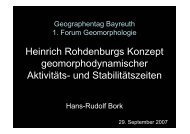Chapter 14 - Limitations on Predictive Modeling in Geomorphology ...
Chapter 14 - Limitations on Predictive Modeling in Geomorphology ...
Chapter 14 - Limitations on Predictive Modeling in Geomorphology ...
You also want an ePaper? Increase the reach of your titles
YUMPU automatically turns print PDFs into web optimized ePapers that Google loves.
LIMITATIONS ON PREDICTIVE MODELING 351<br />
luti<strong>on</strong>, however, must be captured <strong>in</strong> simple rules that can be stated a priori. The rules<br />
must be simple because no significant computati<strong>on</strong>al resources can be devoted to<br />
calculati<strong>on</strong> of <strong>in</strong>tracell dynamics. Such resources have already been used up <strong>in</strong> creat<strong>in</strong>g<br />
f<strong>in</strong>e-scale system resoluti<strong>on</strong>.<br />
This does not necessarily mean that appropriate c<strong>on</strong>stitutive rules cannot be found for<br />
heterogeneous cells, but the rules need to be 'discovered' at the cell level, rather than<br />
derived from fundamental pr<strong>in</strong>ciples of sediment transport. This is the orig<strong>in</strong> of the powerlaw-type<br />
transport rules used <strong>in</strong> geological rec<strong>on</strong>structive model<strong>in</strong>g and landscape<br />
simulati<strong>on</strong>, as discussed above. In such studies, cell rules are <strong>in</strong>voked that are effective <strong>in</strong><br />
creat<strong>in</strong>g f<strong>in</strong>al-state landscapes and stratigraphy that resemble exist<strong>in</strong>g landscapes and<br />
stratigraphy. These rules are not derived directly by averag<strong>in</strong>g over fundamental physicalprocess<br />
models. For example, the sediment discharge model used as a basic cell rule by<br />
Tetzlaff and Harbaugh (1989) <strong>in</strong> their simulati<strong>on</strong> of large-scale fluvial erosi<strong>on</strong> and<br />
depositi<strong>on</strong> resembles the well-known Meyer-Peter and Muller (1948) bedload formulas,<br />
expressible as a power law of mean water discharge or excess shear stress. However,<br />
water discharge or shear stress variati<strong>on</strong>s with<strong>in</strong> a cell, not to menti<strong>on</strong> variati<strong>on</strong>s <strong>in</strong> surface<br />
roughness and gra<strong>in</strong> size, will clearly be substantial for most applicati<strong>on</strong>s, and 'averag<strong>in</strong>g'<br />
is never carried out explicitly. The simulati<strong>on</strong>s of Koltermann and Gorelick (1992), who<br />
studied alluvial fan depositi<strong>on</strong> over a period of 600 000 years us<strong>in</strong>g the Tetzlaff and<br />
Harbaugh (1989) approach, were performed with a horiz<strong>on</strong>tal cell resoluti<strong>on</strong> of 120 m.<br />
The cell-level sediment transport model used <strong>in</strong> such studies, therefore, represents<br />
essentially a new rule postulated, and hopefully c<strong>on</strong>firmed, at a scale much greater than<br />
that at which any physical bedload formula has been, or could be, derived and tested. Such<br />
transport rules are not 'averaged' results of laboratory-scale bedload formulas, but should<br />
be regarded as new discovered or emergent rules, to be tested, and then used or discarded<br />
<strong>on</strong> their own merits. Thus, rules for large-scale applicati<strong>on</strong>s should be chosen <strong>on</strong> the basis<br />
of known c<strong>on</strong>stra<strong>in</strong>ts, such as mass c<strong>on</strong>servati<strong>on</strong>, dependence <strong>on</strong> variables thought to be<br />
important (such as local discharge rates) and <strong>on</strong> the basis of calibrati<strong>on</strong> (fit) to specific<br />
field-scale studies. Such rules are not based up<strong>on</strong> fundamental transport physics, but up<strong>on</strong><br />
observati<strong>on</strong>s (field collecti<strong>on</strong> of data) and experience with the model<strong>in</strong>g requirements of<br />
the landscapes of <strong>in</strong>terest.<br />
EXTERNAL FORCING<br />
External forc<strong>in</strong>g arises <strong>in</strong> an open system where mass, energy, and momentum can enter<br />
and be discharged through the system boundaries. Like some of the other sources of<br />
uncerta<strong>in</strong>ty, external forc<strong>in</strong>g becomes an <strong>in</strong>creas<strong>in</strong>gly important factor <strong>in</strong> predicti<strong>on</strong> as<br />
system size <strong>in</strong>creases. While laboratory experiments are usually carried out at a scale<br />
where isolati<strong>on</strong> from external events is possible, large systems are always exposed to the<br />
vagaries of nature such as storms and climate change. In fluvial sediment transport,<br />
external forc<strong>in</strong>g may be due to <strong>in</strong>creases of discharge result<strong>in</strong>g from storms or dam<br />
releases, to <strong>in</strong>jecti<strong>on</strong> <strong>in</strong>to the ma<strong>in</strong>stream of quantities of water and sediment from side<br />
channels and slopes fall<strong>in</strong>g outside the model boundaries, to backwater effects due to<br />
stream impoundment or ris<strong>in</strong>g sea level, to tect<strong>on</strong>ic uplift, and to base level lower<strong>in</strong>g. The








